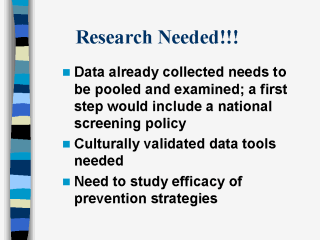 |
Prevention and Control
African American women demonstrate a high prevalence of potentially modifiable risk
factors thus primary, secondary and tertiary prevention strategies, particularly those
aimed at limiting hypertension would likely prove very beneficial. African American women
aged 25 to 54 years whose age adjusted risk is significantly higher than whites results in
an increased years per life lost (YPLL) need to be given particularly aggressive
attention. It is well established that the quantity of knowledge about CHD determinants,
behavioral change, and availability of preventative and therapeutic resources is greater
as socioeconomic status increases. Because many African American women are
socio-economically disadvantaged, risk factor modification is likely to prove to be very
challenging. Because African American women tend not to access standard health care
facilities, community based interventions at churches, work sites and schools may prove to
be particularly helpful. One unique approach to community intervention for reducing
cardiovascular disease risk in blacks is currently being conducted in Baltimore Md. In
this program, a clergy/academic partnership between Clergy United for Renewal in East
Baltimore (CURE) and Johns Hopkins University called Heart Body and Soul Inc. has been
formed (25). The mission of Heart Body and Soul is to narrow the health gap between
African Americans and whites by mobilizing community resources to identify and treat CHD
in blacks (25). Preliminary results suggest that the inclusion of a clergy component in
this research project minimizes barriers to both research and treatment by eliminating
some of the suspicion and mistrust that is typically associated with such research
endeavors. |
